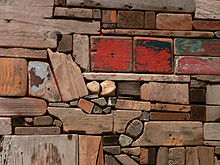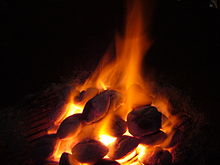Solid fuel refers to various types of solid material that are used as fuel to produce energy and provide heating, usually released through combustion. Solid fuels include wood (see wood fuel), charcoal, peat, coal, Hexamine fuel tablets and pellets made from wood (see wood pellets), corn, wheat, rye and other grains. Solid-fuel rocket technology also uses solid fuel (see solid propellants).
A fire made of charcoal briquettes.
Solid fuels have been used by humanity for many years to create fire Coal was the fuel source which enabled the industrial revolution, from firing furnaces, to running steam engines. Wood was also extensively used to run steam locomotives. Both peat and coal are still used in electricity generation today.
The use of some solid fuels (e.g. coal) is restricted or prohibited in some urban areas, due to unsafe levels of toxic emissions. The use of other solid fuels such as wood is increasing as heating technology and the availability of good quality fuel improves. In some areas, smokeless coal is often the only solid fuel used. In Ireland, peat briquettes are used for home heating. They are also used to start a coal fire.
Solid fuels are contrasted with liquid fuels and gaseous fuels.
Coal Reserves The amount of coal worldwide is approximately 1 trillion metric tons while more are still left over in unknown areas. United States currently holds the majority of coal and bituminous reserves while Russia comes in second, and China follows behind in third. The United States currently holds around 400 years of coal in now established reserves, which are currently in use. True totals of coal reserves can conceivably be higher if using accessible mining methods and could even be higher if new methods are presented. Canada is also a contender in this list, but it is left unexploited in the region east of the Alberta oil sands deposits. Coal, because of its comparatively low cost comes out to be the most likely to fuel the world’s energy needs. Problems do appear from coal consumption though, from its high carbon content. Solutions to this problem can be solved from removing carbon before the burning of it but because of how carbon contributes to most of the thermal energy from coal, it would be useless in doing so. There has been a lack of natural gas as of lately; this could result in the United States to look for alternative sources of fuel besides from coal.
Biomass and Ethanol Reserves
Biomass is collected from large volumes of plant origin, which include corn or wood waste. Biomass does not just include these two substances though; it can range from leftover grass to surplus pulp.mJohn R. Wilson and Griffin Burgh say although the needed machinery is not currently available but that a variation of feedstock are readily available for use in producing ethanol from cellulosic biomass. They continue saying that even more materials are being considered such as agricultural waste, forest residue, and municipal solid waste if of dependable makeup and worth, and energy crops such as fast-growing poplar. The big issue from ethanol conversion comes from the cost issue of the selection of such feedstock, as well as environmental issues. An example of such feedstock include forest thinnings. The problem of forest thinnings do not come in large amounts but can be collected at a low cost, the set back is that collection costs rises as the amount increases.
Nuclear Power
Another type of solid fuel includes nuclear power, which uses uranium ore. The use of fossil fuels has been declining throughout the decades; this brings the issue of creating a source that has zero-carbon. An option for this source that has zero-carbon includes nuclear power. Nature does not provide nuclear power from its origin form so it is extracted from uranium ore. A rock that has a content of more than 0.1% is considered to be workable. A problem with mining uranium ore is that it creates large amounts of waste that contains a lot of radioactive residues and additionally some non-toxic substances. Another problem with using uranium ore is that the earth only has a limited amount of it and if the earth were to switch entirely onto nuclear power, the source would be depleted in a relatively short amount of time. France currently uses nuclear power for the majority of their electricity supply, while countries like Australia, Austria, Denmark, Norway, and Portugal do not use any nuclear power at all.
Municipal Waste
Municipal solid waste (MSW) has been considered a candidate for a reliable and economical energy source. As a part of the solid waste management chain, advanced technologies are currently available for combustion and gasification of waste. Some thought has been to include municipal waste when being co-fired with other supporting fuel in cement kilns to provide extra BTUs but this has proved to be expensive due to pollution controls and process-equipment fouling.
Uranium235
Uranium-235 (235 U) is a solid fuel used in the production of energy. Fission of the Uranium-235 is caused by bombarding it with neutrons. 1 In doing so the fission process creates new free neutrons that will continue the fission process. The process causes the mass of the uranium atom to be reduced from its original size. 1 The reduction in size is converted to energy in the form of heat.The heat produced creates steam that is used to in steam turbines to create electricity.
Waste
Spent uranium fuel rods are reprocessed after use to recover fissile materials for use in nuclear power plants. This reprocessing gains 25% to 30% more energy from the original fuel. Reprocessing also reduces the amount of spent fuel to be disposed of to about one fifth. The reprocessed fuel's radioactivity has a decay rate that falls much faster than that of the non-reprocessed fuel.
Resources
World uranium resources are divided into two main categories by the Organization for Economic Co-operation and Development, Nuclear Energy Agency and the International Atomic Energy Agency; reasonably assured resources and inferred resources. These categories are further split into categories by the cost of recovery and processing. Reasonably assured resources are those that occur in known mineral deposits that can be recovered with the current production cost associated with mining and production technology currently in use. Inferred resources refer to the uranium that is inferred to occur based on geological evidence. Of the reasonably assured resources in the world there is estimated to be 10,342,900 tons. Of the inferred resources that can be mined there is an estimated 5,840,300 ton bringing the total to 16,187,200 tons. In addition to these resources uranium can also be extracted from seawater. The concentration of uranium in seawater is about 3.2 parts per billion adding up to about 4 billion tons of uranium. The energy content of seawater recovered uranium is very diluted. The cost of extracting uranium from seawater is considerably higher than that of land based resources. Of all the worlds identified uranium resources Australia tops all countries with 31% of the low cost uranium (<$130 per kg) and 25% of the high the high cost uranium (<$260 per kg). Kazakhstan comes in second with 12% in both categories and all other countries fall far behind.
Types of Solid Fuels

Wood is one of the most commonly used solid fuels.
WoodWood is a unique fuel source in that it is a renewable resource. It is also greenhouse gas neutral which means that the log being burned cannot produce any more carbon than was used by it during its life. When burning wood, it is important to allow at least one year's time for it to dry out completely. If burnt with water still inside it, or while it is "green", heat will be wasted turning that water into steam and will produce acidic tars that can damage heating appliances.
Biomass
Biomass is plant material taken to be used as fuel. While wood is a type of biomass, other plants commonly used for fuel include wheat, straw, nut shells, or any fibrous material.
Peat
Peat is a form of coal. In the life cycle of coal, biomass decomposes over thousands of years and becomes peat and then after thousands more years, becomes lignite, and then coal. Once it is dried, peat becomes extremely volatile.
Lignite
Lignite is another stage in the coal making process. This fuel burns relatively easily. A disadvantage is that it will produce large amounts of ash.
Bituminous Coal
Bituminous coal is made from wood compressed by the earth's crust and aged about one hundred million years. The coal is economically efficient and the flame produced is highly desirable with low ash output. However, The smoke produced by this fuel is dark and contains flammable gasses that if not properly contained, can produce a dangerous environment.
Anthracite
Anthracite is a smokeless coal that was formed over the course of over three hundred million years. Its density allows it to burn for long periods of time without producing very much smoke. Also due to its density, it is very difficult to light and often requires the use of a second, easier burning fuel to help in the process.
Coke
Coke is a coal-like fuel source that are produced by heating natural coal in specialized containers to burn only the oily surface off of the coal. The result is a hard brick that while difficult to light, can last extremely long.
BriquettesBriquettes are generally non-organic blocks of fuel that are made of compressed minerals. Their flames will last long periods of time.
Benefits
Solid fuels, compared to liquid fuels or gaseous fuels, are more readily available. Coal, in particular, is utilized in the generation of 38.1% of the world’s electricity because it is less expensive and more powerful than its liquid and gas counterparts. In homes, wood can be used for heating and cooking and depending on ones location, it can be much cheaper than other fuels.
Disadvantage
In an industrial situation, especially in the maritime industry, solid fuels become increasingly difficult to work with. Compared to liquid and gas fuels, solid fuels require a much larger area to store because both liquids and gases will expand and contract more easily with pressure and temperature variants making them more easily compressible. The solid fuel also tends to have a higher nitrate and sulfate emission rate. From 2009 to 2013, nearly 36% of the United States CO2 emissions were due to the burning of solid fuels.
References
- ^ a b c d e f g h i j k l [Wilson and Burgh. (2008). Energizing Our Future: Rational Choices For The 21st Century. New Jersey: John Wiley & Sons, Inc.]
- ^ Quaschning, V. (2005). Understanding Renewable Energy Systems. London: Earthscans
- ^ a b c Organization for Economic Co-operation and development, Nuclear Energy Agency. Uranium 2011: Resources, Production and Demand, Joint Report of OECD Nuclear Energy Agency and IAEa. (OECD 2012).
- ^ Bodansky, D. (2004). Nuclear Energy: Principles, Practices, and Prospects. New York: Springer.
- ^ a b c d e f g h "Solid Fuels". Solid Fuel Technology Institute. 9 February 2014. Retrieved 22 June 2015.
- ^ Research of coal-masut agglomerate as fuel / Biletskyy V.S., Kheloufi, A. // III International Conference on Catalysis and adsorption in fuel Processing and environmental Protection / September 15-18, 1999, Kudowa Zdroj, Poland. - Oficyna Wydawnicza Politechniki Wroclawskiej. - Wroclaw 1999. P. 409-414.
- ^ a b "The Guide to Solid Fuels" (PDF). Solid Fuel Association. Retrieved 22 June 2015.
- ^ "Guide To Solid Fuel". Coal Products Ltd. Retrieved 22 June 2015.
- "CO2 Emissions (metric Tons per Capita)." Data. N.p., n.d. Web. 25 March 2014.
- "Coal Facts." Coal Facts. N.p., n.d. Web. 25 March 2014.
- "Heating Options for Your Home Buying Guide." Electricity, Gas or Solid Fuel? - CHOICE Reviews Heating Options for Your Home. N.p., n.d. Web. 25 March 2014.
- Solid Fuel Guide & Advice
- Wikipedia






No comments:
Post a Comment